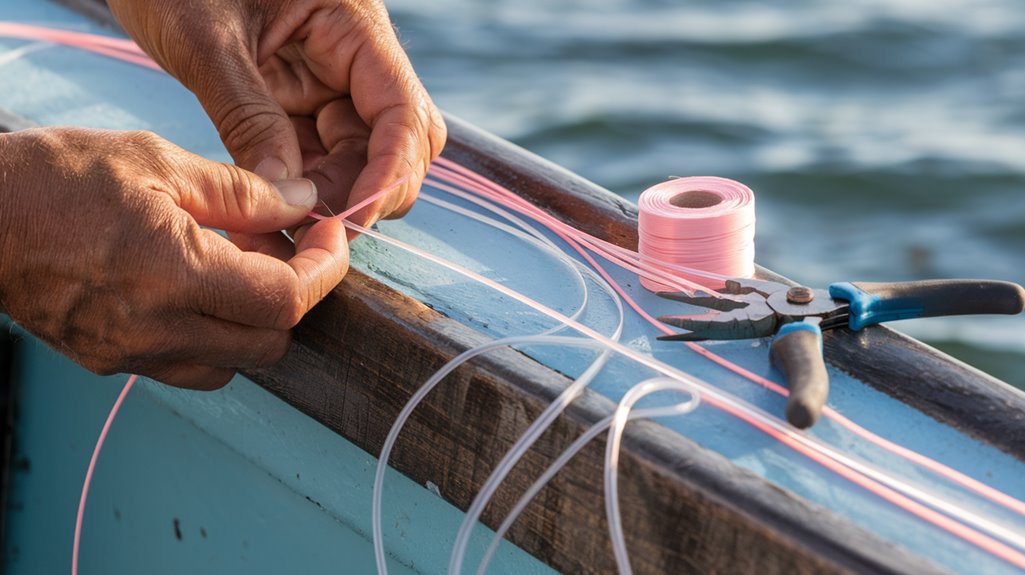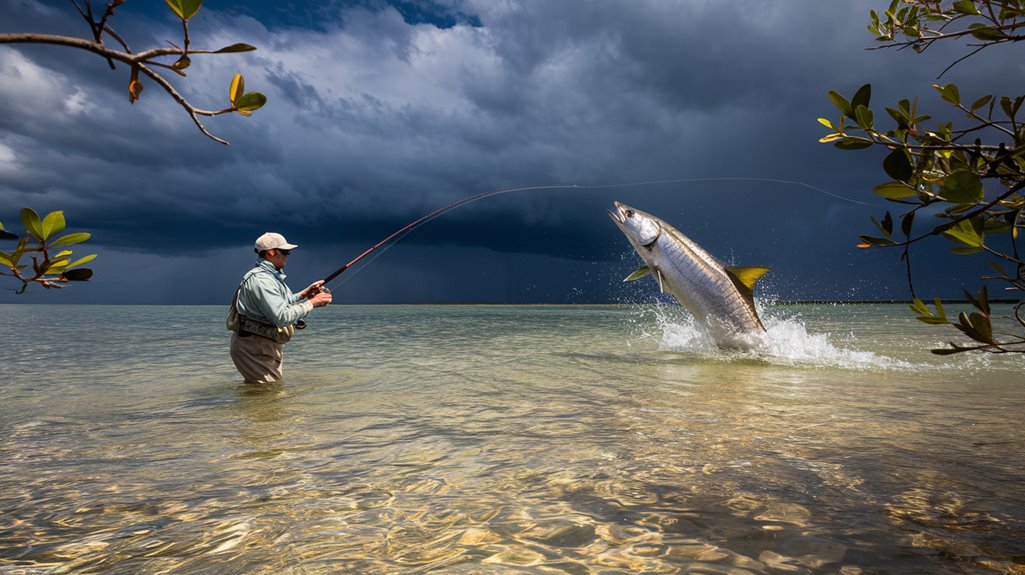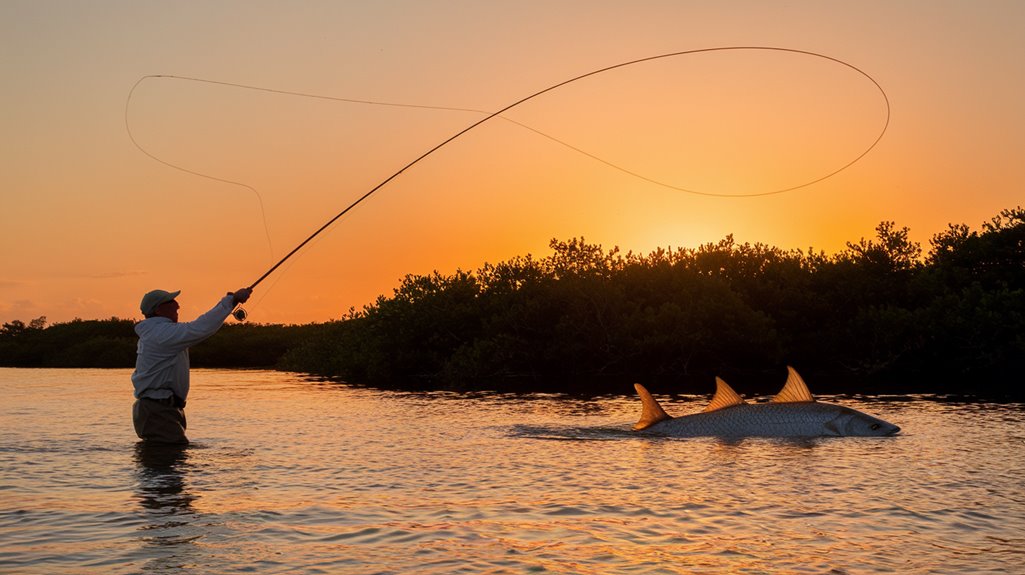You'll find tarpon fly fishing to be one of angling's most rewarding challenges, blending technical skill with raw excitement. From positioning your boat in the dawn light to executing that perfect double haul cast, every element must align for success. Whether you're targeting baby tarpon in the mangroves or hunting hundred-pounders in open water, mastering the right techniques will transform your encounters with these prehistoric gamefish from mere chances into consistent hookups.
- Key Takeaways
- Essential Gear and Equipment Setup
- Understanding Tarpon Behavior and Migration
- Mastering the Perfect Cast and Presentation
- Leader Construction and Tippet Selection
- Top Flies and When to Use Them
- Reading Water and Weather Conditions
- Boat Positioning and Anchoring Strategies
- Fighting Techniques and Landing Methods
- Conservation and Proper Fish Handling
- Advanced Tactics for Different Seasons
- Frequently Asked Questions
- Conclusion
Key Takeaways
- Use a double haul casting technique with 8-12 weight rods, matching the setup to tarpon size for optimal control.
- Present flies in the upper water column where tarpon naturally feed, using 10-14 foot leaders for stealth.
- Target areas when water temperatures exceed 72°F, focusing on depths of 6-8 feet near coastal migration routes.
- Maintain steady pressure with low rod tip position during fights, using the reel's drag system effectively.
- Practice casting in windy conditions and use proper gear maintenance to ensure successful tarpon encounters.
Essential Gear and Equipment Setup
Three distinct rod setups are vital for targeting different sizes of tarpon effectively. You'll need an 8-weight rod with floating 9-weight line for baby tarpon, a 10-weight setup for juveniles, and a 12-weight configuration for adults. Your fly reel choice is critical – invest in a high-quality sealed drag system like the Abel SDS or Ross Evolution R Salt to withstand harsh saltwater conditions.
For leaders, rig 10-14 feet with 20-30# class tippet for smaller fish, or opt for straight 80 lb fluorocarbon when pursuing adult tarpon. Stock your fly box with proven patterns like the Tarpon Toad, Black Death, and EP's Black and Purple Peanut Butter in sizes 1/0 to 4/0. Don't forget to maintain your gear regularly, cleaning and lubricating your reel to guarantee peak performance.
Understanding Tarpon Behavior and Migration
You'll find tarpon moving along coastlines when water temperatures hit 72°F, with peak migration occurring as waters warm beyond 78°F in both northbound and southbound patterns. These powerful gamefish prefer depths of 6-8 feet but won't hesitate to cross shallow sandbars during their seasonal movements, making it essential for you to understand their preferred habitat conditions. To increase your chances of a successful catch, you'll need to present your flies in the upper feeding zone where tarpon actively hunt, aligning your strategy with their natural feeding behaviors and instincts.
Seasonal Movement Patterns
To master tarpon fishing, you'll need to understand their predictable migration patterns, which begin when coastal waters reach 72°F and peak above 78°F. These migratory tarpon follow both northbound and southbound routes, seeking ideal water temperature and abundant food sources throughout their journey.
| Migration Factor | Impact on Fishing Practices |
|---|---|
| Water Depth | Target 6-8 feet zones |
| Temperature | Start at 72°F, peak at 78°F+ |
| Feeding Zone | Present flies in upper water column |
| Movement Routes | Both north and south migrations |
| Habitat | Include shallow sand bar crossings |
You'll find the most success by positioning your flies in the upper feeding zone where tarpon are actively hunting. Watch for their movements across shallow sand bars as they travel between feeding and spawning grounds, and adjust your fishing strategy according to tidal conditions and water temperatures.
Preferred Habitat Conditions
Understanding tarpon's preferred habitat conditions starts with their temperature sensitivity and depth requirements. You'll find these fish actively moving once waters reach 72°F, with peak activity above 78°F. While adult tarpon typically prefer depths of 6-8 feet, they'll readily cross shallow water during migration periods.
Habitat preferences vary by life stage, with juvenile tarpon seeking protection in shallow mangrove lagoons, while adults venture into deeper offshore waters. You'll need to adjust your fishing strategy based on where these fish are holding in the water column, as they frequently feed near the surface. Water clarity and depth play significant roles in their habitat selection, particularly during their seasonal movements from spring through summer when they're focused on spawning activities.
Feeding and Hunting Instincts
Successful tarpon fishing hinges on recognizing their distinct feeding and hunting patterns as they migrate along coastal waters. You'll find these fish most active when temperatures exceed 78°F, targeting their feeding zones in 6-8 feet of water. Watch for surface activity, fins, and ripples that signal their presence.
| Behavior | Water Depth | Best Approach |
|---|---|---|
| Surface Feeding | 0-2 ft | Skip cast flies |
| School Formation | 6-8 ft | Deep presentations |
| Bar Crossing | 2-4 ft | Lead the fish path |
When fly fishing for tarpon, you'll need to adjust your presentation based on their hunting instincts. Observe their movement patterns across shallow sand bars and position yourself accordingly. Remember that tarpon fishing success depends on patience and timing, as these predators' activity levels fluctuate with environmental conditions.
Mastering the Perfect Cast and Presentation
Anyone who's pursued the mighty tarpon knows that precise casting and presentation make the difference between success and frustration on the water. To master your approach, you'll need to perfect the double haul technique, which maximizes your casting distance and accuracy when targeting these powerful gamefish.
When presenting your fly, focus on the upper water column where tarpon actively feed on baitfish. You'll want to use a 10-14 foot leader to guarantee a natural presentation that won't spook these wary predators. Position your cast slightly ahead of sighted fish, allowing them to intercept your fly naturally. Don't let challenging conditions deter you – practice casting in windy situations to build the skills you'll need on the water. This preparation will help you deliver accurate presentations when opportunity strikes.
Leader Construction and Tippet Selection

A properly constructed leader and tippet system forms the critical connection between your fly line and the tarpon of your dreams. You'll want to build your leader between 10-14 feet long, with 11-12 feet being ideal for juvenile tarpon strikes. When targeting adult tarpon, you'll need an 80 lb fluorocarbon shock tippet to handle their abrasive mouths and powerful runs.
While traditional leader construction with a shock tippet remains effective, you might consider using straight 80 lb fluorocarbon for enhanced durability. Whatever system you choose, make certain your connections between fly line, leader, and tippet are rock solid. Don't forget to inspect your setup regularly for wear and damage – replacing worn components before they fail will save you from losing the fish of a lifetime.
Top Flies and When to Use Them
Your success with tarpon depends heavily on choosing the right fly pattern for the conditions you encounter. You'll want the Tarpon Toad for active feeding periods, the Black Death for low-visibility situations, and EP's Black and Purple Peanut Butter when fish are targeting smaller baitfish. Water depth and clarity should guide your selection between slow-sinking patterns for the flats and surface flies for dawn and dusk feeding.
Must-Have Tarpon Patterns
Several proven tarpon fly patterns have emerged as must-haves in every serious angler's box. You'll want to stock the Tarpon Toad in sizes 1/0 to 3/0, the Black Death in 3/0 to 4/0, and EP's Black and Purple Peanut Butter in 3/0. These effective tarpon flies deliver consistent results across various conditions.
For fly color selection, focus on black and purple combinations for low-light conditions, brown and tan patterns for clear water, and Florida yellow when visibility is essential. When targeting juvenile tarpon fishing, pair these flies with 11 to 12-foot leaders for better presentation. For shallow flats, choose lightweight, slow-sinking patterns, but don't forget to pack some top-water options for those exciting surface feeds. During special events like the Palolo worm hatch, specific patterns can dramatically improve your success rate.
Conditions Drive Fly Selection
Successful tarpon fishing depends heavily on matching your fly selection to the prevailing conditions. Water clarity dictates your color choices, with black, purple, brown, and Florida yellow patterns proving most effective. During Palolo worm hatches, you'll want to switch to worm-like flies such as Gordon's Stiff Worm to match the natural forage.
Tarpon anglers should consider depth when selecting their lines for tarpon fishing. In shallow flats, opt for lightweight slow-sinking or top-water dry flies when fish are feeding near the surface. Match your fly size to your target fish, using hooks from 1/0 to 4/0 depending on conditions. Don't let rain deter you – surface disturbances from precipitation can actually improve your chances of a strike.
Reading Water and Weather Conditions

Understanding the interplay between water and weather conditions is critical for productive tarpon fly fishing. You'll find your first tarpon when water temperatures reach 72-78°F, as these fish become most active in this range. When reading water conditions, pay attention to incoming tides, which push baitfish into shallower areas where tarpon actively feed.
Watch for surface disturbances that signal feeding activity. A light breeze creates ideal conditions by rippling the water's surface, making it harder for tarpon to spot you. Don't let rain discourage you from hitting the tarpon fishery – these conditions often trigger increased feeding behavior. Look for rolling or splashing on the surface, as these signs indicate where tarpon are actively feeding. These visual cues are essential for positioning yourself for the perfect cast.
Boat Positioning and Anchoring Strategies
You'll want to position your boat in 6-8 feet of water where tarpon actively feed, using your trolling motor sparingly to avoid spooking these sensitive fish. When anchoring, carefully consider both wind and tide directions, as they directly influence tarpon movement patterns and your ability to present flies effectively. Keep your anchor placement strategic by watching for surface disturbances and fins, which indicate prime fishing zones where you can intercept migrating tarpon.
Anchor Location Best Practices
When targeting tarpon with a fly rod, proper boat positioning and anchoring can mean the difference between a successful day and a frustrating one. For a successful Tarpon trip, you'll want to position your boat strategically in relation to wind and tide, while maintaining the visibility of your leader to attract more strikes.
- Set your anchor in 6-8 feet of water, where tarpon typically cruise during their migration patterns
- Position your boat to account for both wind direction and tidal flow, maximizing your presentation angles
- Use your trolling motor sparingly to maintain position, avoiding sudden movements that might spook fish
- Consider nearby sand bars and shallow areas that tarpon may cross, ensuring you're anchored in their natural path
Motor Positioning for Success
Three key factors determine ideal motor positioning for tarpon fishing: wind direction, current flow, and the fish's anticipated path. You'll need to maintain effective boat positioning in 6-8 feet of water while using your trolling motor sparingly to avoid spooking the fish. This strategic placement guarantees natural fly presentation and enhances your chances of success.
| Position Element | Action Required |
|---|---|
| Depth | Stay in 6-8 feet |
| Motor Use | Minimal trolling |
| Boat Direction | Face the current |
| Wind Factor | Account for drift |
| Tarpon Activity | Monitor patterns |
Position your boat to intercept tarpon's travel routes while considering tide and wind conditions. When you spot feeding patterns, adjust your location accordingly, but maintain stealth. Remember that proper anchoring creates a stable platform, essential for accurate casting and keeping your boat in the best strike zone.
Fighting Techniques and Landing Methods
Successfully landing a tarpon requires mastering specific fighting techniques that differ from other gamefish. Keeping your rod tip low increases your odds of landing these powerful fighters, as their hard mouths can easily throw hooks when the tip is raised too high. Even with baby tarpon, maintain steady pressure through your disc drag while stripping line to help the fish turn and set the hook deeper.
- Strip line continuously after hook-set while keeping the rod low
- Apply strong, consistent pressure to tire the fish during jumps
- Guide the tarpon gradually toward the boat without sudden movements
- Handle with care alongside the vessel, avoiding lip-grips
When the fish is boat-side, you might need to enter the water to properly revive it before release, ensuring its survival for future anglers.
Conservation and Proper Fish Handling
Proper fish handling and conservation practices stand at the forefront of responsible tarpon fishing. You'll need to minimize air exposure and handle these magnificent fish horizontally when removing them from water to maximize their survival rates. Match your tackle to the tarpon's size to prevent exhausting fights that can increase mortality.
After landing, you must properly revive your catch by moving it forward through the water, allowing oxygen to flow through its gills. If you've got an exhausted fish, relocate it to reduce predation risk. Organizations like the Bonefish and Tarpon Trust champion sustainable fishing practices through habitat protection and spawning strategy research. By following these handling guidelines and supporting conservation efforts, you're helping guarantee tarpon populations thrive for future generations of anglers.
Advanced Tactics for Different Seasons
When targeting tarpon throughout the year, you'll need to adjust your tactics to match their seasonal behavior patterns. As a dedicated fly fisher, understanding these seasonal shifts will greatly improve your success in saltwater fishing.
- Spring – Focus on shallow mangrove areas where big tarpon migrate. Use surface presentations and sight fishing techniques for best results.
- Summer – Target deep channels and offshore structures. Switch to unweighted flies as adult tarpon become more nomadic.
- Fall – Hunt juvenile fish in backcountry lagoons using 8-10 weight rods for better hookups.
- Winter – Fish deeper channels and estuaries near the coast. Use intermediate lines to effectively reach tarpon in warmer waters.
Remember to adjust your casting technique based on the fish's behavior – lead migrating schools by several feet, but make quick, precise casts during feeding frenzies.
Frequently Asked Questions
What Is the Best Rig for Tarpon Fishing?
You'll need an 8-12 weight rod matched with corresponding fly line, a 10-14 foot leader, 20-30 pound shock tippet, and unweighted flies sized 1/0-4/0 in natural colors.
What Weight Fly Rod Do You Use for Tarpon?
You'll need an 8-weight rod for baby tarpon (5-15 lbs), step up to a 10-weight for juveniles (15-60 lbs), and use a 12-weight rod for adult tarpon (60-140 lbs).
How Old Is a 100 Pound Tarpon?
You'll find that a 100-pound tarpon is typically 10-15 years old. They're slow-growing fish that can live over 80 years, and you can verify their age through growth rings in their scales.
How to Fight a Tarpon on a Fly Rod?
Keep your rod tip low, maintain steady pressure, and let the reel's drag work. When the tarpon jumps, bow to it. Strip line after hookset and don't pump the rod high.
Conclusion
You've now mastered the core techniques needed for successful tarpon fishing. With adult tarpon reaching weights of up to 280 pounds and capable of 100+ aerial displays during a single fight, you'll need every skill in your arsenal. Remember to maintain steady pressure, keep your rod tip high, and prioritize the fish's well-being. By following these guidelines, you'll be well-equipped for your next silver king encounter.

